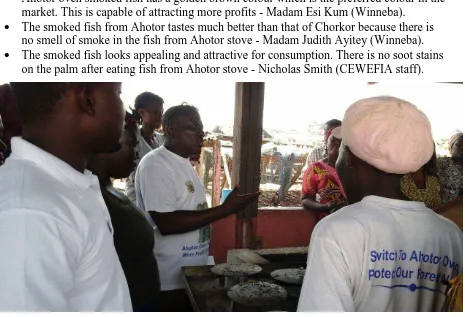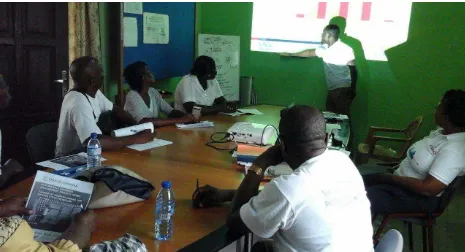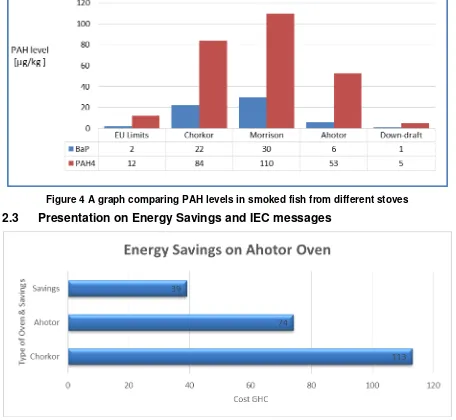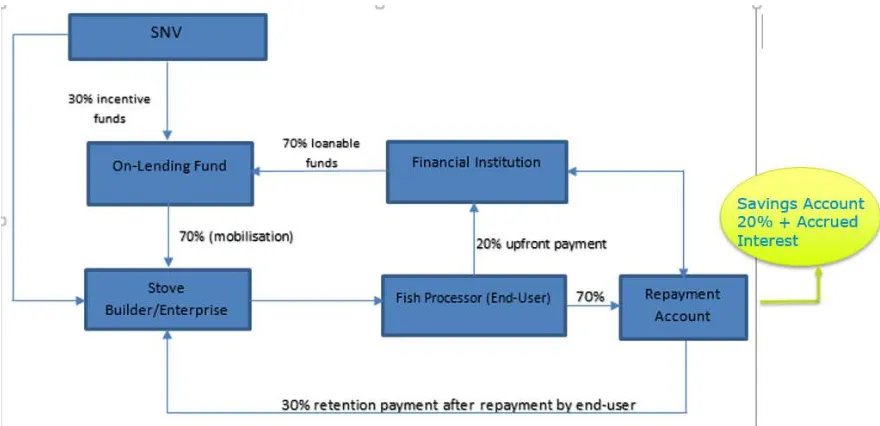SUSTAINABLE FISHERIES
MANAGEMENT PROJECT (SFMP)
Field Support and Coaching Of
Partners; Training on Use Of Ahotor
Oven
This publication is available electronically in the following locations: The Coastal Resources Center
http://www.crc.uri.edu/projects_page/ghanasfmp/
Ghanalinks.org
https://ghanalinks.org/elibrary search term: SFMP
USAID Development Clearing House
https://dec.usaid.gov/dec/content/search.aspx search term: Ghana SFMP
For more information on the Ghana Sustainable Fisheries Management Project, contact:
USAID/Ghana Sustainable Fisheries Management Project Coastal Resources Center
Graduate School of Oceanography University of Rhode Island
220 South Ferry Rd.
Narragansett, RI 02882 USA
Tel: 401-874-6224 Fax: 401-874-6920 Email: [email protected]
Citation: Kwarteng, E. Avega B, (2016). Field support and coaching of partners; training on Ahotor stove use. The USAID/Ghana Sustainable Fisheries Management Project (SFMP). Narragansett, RI: Coastal Resources Center, Graduate School of Oceanography, University of Rhode Island and SNV Netherlands Development Organisation. GH2014_ACT098_SNV 13 pp.
Authority/Disclaimer:
Prepared for USAID/Ghana under Cooperative Agreement (AID-641-A-15-00001), awarded on October 22, 2014 to the University of Rhode Island, and entitled the USAID/Ghana Sustainable Fisheries Management Project (SFMP).
Detailed Partner Contact Information:
USAID/Ghana Sustainable Fisheries Management Project (SFMP) 10 Obodai St., Mempeasem, East Legon, Accra, Ghana
Telephone: +233 0302 542497 Fax: +233 0302 542498
Maurice Knight Chief of Party [email protected]
Kofi Agbogah Senior Fisheries Advisor [email protected] Nii Odenkey Abbey Communications Officer [email protected]
Bakari Nyari Monitoring and Evaluation Specialist [email protected] Brian Crawford Project Manager, CRC [email protected]
Justice Odoi USAID Administrative Officer Representative [email protected]
Kofi.Agbogah #3 Third Nautical Close,
Nungua, Accra, Ghana
[email protected] Daasgift Quality Foundation
Headmaster residence, Sekondi College Sekondi, Western Region, Ghana 233 243 326 178
For additional information on partner activities:
CRC/URI: http://www.crc.uri.edu
CEWEFIA: http://cewefia.weebly.com/
DAA: http://womenthrive.org/development-action-association-daa Daasgift:
https://www.facebook.com/pages/Daasgift-Quality-Foundation-FNGO/135372649846101 Friends of the Nation: http://www.fonghana.org Hen Mpoano: http://www.henmpoano.org
SNV: http://www.snvworld.org/en/countries/ghana SSG Advisors: http://ssg-advisors.com/
ACRONYMS
CEWEFIA Central and Western Region Fishmongers Improvement Association CoP Chief of Party
CR Central Region
CRC Coastal Resources Center at the Graduate School of Oceanography, University of Rhode Island
CSIR Council for Scientific and Industrial Research PAHs Polycyclic Aromatic Hydrocarbons
TOT Training of Trainers FRI Food Research Institute FTT FAO Thiaroye Technology
IEC Information, Education, Communication IIR Institute of Industrial Research
SFMP Sustainable Fisheries Management Project
EU European Union
DAA Development Action Association DAASGIFT Daasgift Quality Foundation
FAO Food and Agricultural Organization of the United Nations FC Fisheries Commission
FtF Feed the Future
GSA Ghana Standards Authority NGO Non-Governmental Organization SNV Netherlands Development Organization UCC University of Cape Coast
URI University of Rhode Island
USAID United States Agency for International Development USG United States Government
WR Western Region
IIR Institute for Industrial Research
TABLE OF CONTENTS
CONTENTS
ACRONYMS ... iii
TABLE OF CONTENTS ... iv
LIST OF FIGURES ... iv
1.0 INTRODUCTION ... 1
1.1 Specific Objectives ... 1
2.0 TRAINING DETAILS... 1
2.1 Training on Stove Use and Benefits ... 2
2.1.1 Feedback from participants ... 3
2.2 Presentation on PAH Levels in smoked fish ... 4
2.3 Presentation on Energy Savings and IEC messages... 5
2.4 Presentation on the financing scheme ... 6
3.0 CONCLUSION ... 7
ANNEX... 8
LIST OF FIGURES
Figure 1 Demonstrating the use of Ahotor oven at Moore ... 2Figure 2 CEWEFIA leading demonstration session at Elmina ... 3
Figure 3 Emmanuel-SNV making presentation on PAH levels in smoked fish to the CEWEFIA team ... 4
Figure 4 A graph comparing PAH levels in smoked fish from different stoves ... 5
Figure 5 Average energy savings on the Ahotor oven per week in the bumper season ... 5
Figure 6 A graphical representation of the financing scheme for Ahotor oven promotion ... 6
Figure 7 Training of DAA staff and coordinators on financing scheme at Winneba ... 8
1.0
INTRODUCTION
The Sustainable Fisheries Management Project being funded by USAID seeks to rebuild marine fisheries stocks and catches through adoption of responsible fishing practices. The project will contribute to the Government of Ghana’s fisheries development objectives and USAID’s Feed the Future Initiative. The Coastal Resource Center (CRC) of the University of Rhode Islands (URI) is the main implementer, working with international and local partners, including SNV Netherlands Development Organization.
According to the SFMP year 3 work plan, SNV will coordinate technical work in the post-harvest area under the supervision of the SFMP fisheries specialist whereas most of the on-the-ground field work with fish processors and mongers will be implemented by DAA, CEWEFIA and DQF in the Central and Western Regions.
SNV will offer technical and coaching support to partners to effectively disseminate the various stove promotion messages developed in year 2. SNV will also provide field level stove awareness creation activation in selected communities in the Volta region. This is necessary to reach impact at scale through support to women fish processors in terms of value addition to their produce.
It is in reference to the above that a technical Training of Trainers was conducted for
CEWEFIA and DAA to train participants on the effective use of Ahotor stove, IEC messages and a financing scheme for the acquisition of the stove.
This training was designed for DAA and CEWEFIA staff, community facilitators, and fisheries officers in the project areas to enhance their understanding of the postharvest technology and mainstream the knowledge in their promotional interventions.
The training of trainers’ activity is part of the coaching programme for partners towards effectively delivering trainings to fish processors on improved ovens and other opportunites. Coaching will be a continuous activity throughout the year which will involve quarterly follow ups and progress evaluation.
This report details the proceedings from the training. 1.1 Specific Objectives
To train participants on the effective use of Ahotor oven for optimum utilization using fish smoking demonstrations.
To increase participants’ knowledge on promotional messages for effective awareness campaigns.
To educate participants on a financing scheme for the improved stove promotion program.
2.0
TRAINING DETAILS
The training was centred on two main areas, one on how to use the Ahotor oven; which was targeted at the fish processors and the second training was for specific coordinators, made up of fish processors, staff of DAA and CEWEFIA; and fisheries officers. They were trained on the promotional messages, the financing scheme, and how to practically use the models in their awareness creation interventions.
Two demonstration trainings on how to use the Ahotor oven, were carried out for each organization. The first session was facilitated by the SNV coordinator (Emmanuel Kwarteng) and the second session was facilitated by the organizations’ (DAA and CEWEFIA)
2.1 Training on Stove Use and Benefits
Figure 1 Demonstrating the use of Ahotor oven at Moore
At Moree, Emmanuel Kwarteng (SNV) led the training. He stated that, Ahotor oven technology was developed with a combined effort of SFMP, CSIR-FRI, FC with testing support from GSA and CSIR-IIR. He also explained that the Ahotor technology is an improvement over the Chorkor stove designed with a combustion system to cut down fuelwood consumption while reducing PAH contamination levels. The combustion system ensures efficient combustion of fuelwood causing less smoke emissions and making the oven more user friendly. He also explained that the presence of the fat collector is to channel the drippings of water, blood, and oil dripping from the fish away from the fire. The oven produces high quality smoked fish with an attractive and appealing colour that enjoys high market demand.
On the effective use of the Ahotor oven, 5 important steps that needed to be followed were stated as follows:
1. Sweep all ashes from the combustion chamber by taking out the grate first. Make sure that there are no ashes blocking the primary air inlet before setting your fire.
2. Before starting the fire, make sure that the grate is pushed deep into the combustion chamber. The grate elevates the fuelwood to allow more oxygen for efficient combustion.
4. Start your fire once everything is in place. Push the fuelwood deep into the combustion chamber to rest on the grate. Once fuelwood is burning well, arrange your fish on the trays as done in the traditional smoking process.
5. Place two containers behind the stove to collect the fat and water drippings from the fish.
After smoking, remove the fat collector and clean it by removing all debris on it. After the demonstrational training at Moore, the smoked fish was shared among participants for their feedback on the taste, outlook and texture of the fish. They all gave positive verdict on the quality of the fish. Sixteen (16) fish processors from Moore participated in the training. The same training was repeated the following day October 25, 2016 at Elmina-Ayisa for beneficiaries in Elmina, Anlo beach and Sekondi. A representative from CEWEFIA (Nicholas Smith) led the demonstration training. This exercise was intended for CEWEFIA staff to demonstrate their understanding of the training content and to ensure that the right message or information on the Ahotor is communicated. Twenty four (24) fish processors participated in the training.
2.1.1 Feedback from participants
Ahotor oven smoked fish has a golden brown colour which is the preferred colour in the market. This is capable of attracting more profits - Madam Esi Kum (Winneba).
The smoked fish from Ahotor tastes much better than that of Chorkor because there is no smell of smoke in the fish from Ahotor stove - Madam Judith Ayitey (Winneba).
The smoked fish looks appealing and attractive for consumption. There is no soot stains on the palm after eating fish from Ahotor stove - Nicholas Smith (CEWEFIA staff).
Figure 2 CEWEFIA leading demonstration session at Elmina
2.2 Presentation on PAH Levels in smoked fish
This training was limited to DAA and CEWEFIA staffs, their community facilitators, influential women leaders and fisheries officers in the project areas. The relevance of PAH levels in smoked fish was explained in detail to participants for their understanding and effective communication. Using PowerPoint presentation, Emmanuel explained that the smoking and drying techniques of the traditional stoves have quality and food safety issues caused by high levels of polycyclic aromatic hydrocarbons (PAHs) in the smoked fish in the Ghanaian market. He explained that PAHs are carcinogenic, fat soluble, nonvolatile and extremely persistent, and develop especially during the incomplete combustion of organic materials. Globally, PAH levels in food are monitored by regulatory agencies with a combination of four compounds (PAH4) being of specific interest: benzo[a]anthracene, chrysene, benzo[b]fluorantene and benzo[a]pyrene. Under EU food standards, the level of PAH4 in smoked food products should not exceed 12 µg/kg and for benzo[a]pyrene (BaP) 2 µ/kg.
Figure 3 Emmanuel-SNV making presentation on PAH levels in smoked fish to the CEWEFIA team
He indicated that, recent SFMP analyses have shown that smoked fish contains PAH levels that are well above those recommended for human health, with the Chorkor stove some 7-10 times the EU standard. One very recent study sampled hard-smoked fish (smoked with chorkor ovens) from markets across multiple coastal regions and found PAH4 levels in excess of 400 µg/kg.
The formation of PAH is a complex but little understood process. With respect to traditional fish smoking practices, PAH formation is dependent on the stove technology, fish species, wood type and smoking method. Through literature reviews and project research it appears that other influencing factors include the incomplete combustion of wood, dripping of fat into open fire, and exposure to excessive heat and smoke.
Figure 4 A graph comparing PAH levels in smoked fish from different stoves
2.3 Presentation on Energy Savings and IEC messages
Figure 5 Average energy savings on the Ahotor oven per week in the bumper season
This training followed from the PAH training. Mr. Kwarteng, leading the training explained that a previous study conducted at Anlo beach in the early part of the project year 2 on the topic “Energy Expenditure Budget for the Fish Smoking Business” indicated that, an average fish processor using Chorkor oven spends an average of GHS 112.66 on fuelwood per week in the bumper season. Figure 5 explains the energy savings potential of the Ahotor oven. He also said that during the bumper season, fish processors put in maximum effort to take advantage of the bumper season by preserving as much fish as they can. This requires huge expenditure on fuelwood. On the average, a processor using Chorkor spends GHS 2,700 on fuelwood alone over the 4 months bumper period. Using the Ahotor oven will cut down this expenditure to GHS 1810, resulting in savings of about GHS 890 on fuelwood.
On Information, Education and Communication (IEC) messages, Mr Kwarteng explained that as we are at the technology diffusion stage of the program, the awareness messages should concentrate on the technology. The messages listed and explained to participants included
3. For quality fish, smoke with the Ahotor oven.
4. To maximize fish processor profit, use Ahotor oven. 5. Our mangroves, your future, use Ahotor oven. 6. Purchase Ahotor oven to save our mangroves. 7. Use Ahotor oven, save your life!
2.4 Presentation on the financing scheme
Using the diagram below, Emmanuel explained that the project provides an early adopters’ incentive of 30% of the total cost of the stove limited to the first 200 adopters. Afterwards the incentive package ends the stove will be purchased at full cost. He told the participants to encourage fish processors who have expressed interest in purchasing the stove to open a savings account with GN Bank and start savings. The bank requires at least 20% of the loan amount as a cash collateral. This money stays in the savings account of the beneficiary and is accessible after payment of the loan. Figure 6 explains the concept.
Figure 6 A graphical representation of the financing scheme for Ahotor oven promotion
He further explained that, the financial institution will advance 70% of cost of the oven which is the only amount that will attract interest for the bank. This is in the case of those who will benefit from the early adopters’ incentives.
3.0
CONCLUSION
Participants’ contributions in the form of questions and positive statements illustrate an increase in their knowledge on the IEC messages, financing scheme calculations, and Ahotor stove use. They appreciated the need for a change from the old technology of smoking to the Ahotor technology, knowing the effect of PAH on health impact.
The high cost of the stove was the issue for most processors. However, it was established that although the initial cost of purchasing the Ahotor stove may be high, the savings on fuelwood pays back in due time. Also the project has made an arrangement with financial institutions with loans to support interested persons who do not have the full amount to purchase the stove.
ANNEX
Figure 7 Training of DAA staff and coordinators on financing scheme at Winneba





